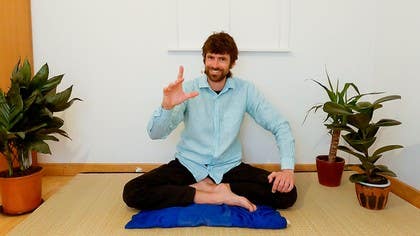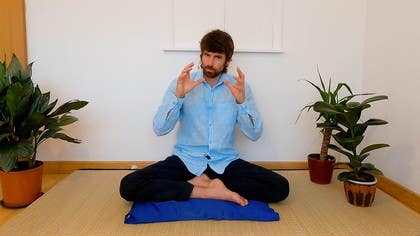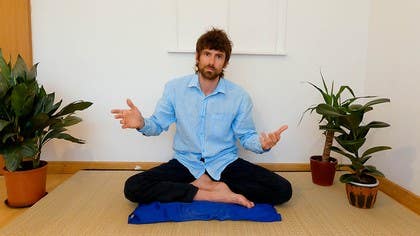Description
About This Video
Transcript
Read Full Transcript
Patanj is laid out. We have these afflictive potences that are part and parcel of embodied existence. When we live in this field of changing reality, it very readily gives rise to avidya. And Patanj is going to give us a lot of clear insight into why that happens shortly. So we're going to hear about how to deal with avidya in very comprehensive detail. So he's told us there are these kleshas, now what to do about them? So the tense sutra, Patanj says te, and te refers, it means these, so these kleshas, te kleshaa, te pratiprasava heyaa, sukshmaa. And then in the 11th sutra, dhyana heyaa sthadvrita yaha. So here we have two levels or stages of how to overcome or dissolve or deal with these kleshas. And interestingly, Patanj actually starts with the subtle first. Te pratiprasava heyaa sukshmaa. So this basically means when te, when they, when these kleshas are in their subtlest form, pratiprasava, when they are basically returned back to the source, then it's as if they fade away. The seeds of them become as if burnt, and then they can no longer sprout. So if we're able to bring our awareness of how these kleshas operate within our field of awareness all the way back to the source, if we're able to then take our awareness back to the source and reside in that state of oneness, then from that state of oneness, when we recognise ourselves as one, and we see the whole vastness as one, then it's like there's no ground of separation of partial perspective that's going to allow these kleshas to then sprout and grow and start to become enmeshed. Okay, well and good, but that's not where I am today. That's good to know for future reference, and if I experience that I'll think, oh great, sutra 10. That's what Patanj was talking about. But today I am enmeshed in all of these kleshas and their compound myriad confounding effects. What to do about them in this form, and this is where Patanj continues.
Dhyana heya as tad vrittaya. So tad vrittaya, their vrittis, when they are moving, when they are rolling, whirling, operating, when they are manifest and operative, when these kleshas are active and they're afflicting me, they're getting in my way, what to do about them then. I'm not in that state of complete oneness. I can't take my awareness and my experience, the kleshas, all the way back to the source of infinite oneness. So what to do about it now in the interim? Dhyana heya tad vrittaya. Dhyana, meditation, meditative efforts, the invitation and cultivation, experiences of the meditative state, is the way to mitigate and overcome the influence of the kleshas. More than once potentially tells us the problem is avidya, the problem is this partiality and the solution, the remedy, is the cultivation of samadhi, the cultivation of the medistate, the state in which we can see much more easily with that global 360 degree equivision. So as we invite more and more experience of totality, of steady centered impartial awareness, then slowly steadily the modifications, the whirlings, the beguiling miasmic effects of the kleshas can be overcome as we cultivate that steadiness. So one way we can think about it is that if we accept and recognise ah yes I am often as it were bound by, contained within, veiled, blinkered, it's like I'm in a valley of my habitual perceptions. I don't know if I'm allowed to sing a song by a very famous recording artist but I'm going to go for it and take the risk anyway I don't think you'll mind but Bruce Springsteen had a song called The River and he says in this song he says I come from down in the valley where mister when you're young they bring you up to do like your daddy done how true this is we come from down in the valley where they bring us up to do like the previous generation has done we inherit so many ideas and these ideas they build up a construct of what we expect reality to be like all around us so it's like we live in this valley and the valley walls the constructs of our received ideas those ideas about reality that we've allowed ourselves to become adhered to or allow the idea to adhere somehow to us and our sense of who we are and so when I'm in the valley and I'm down in the valley what do I see I don't see the vastness of the horizon of reality I see these valley walls the idea is when I invite Diana when I invite that steady centered awareness it's like the walls of the valley I start able to see more accurately that they are not the real picture and my awareness starts to open up into a vaster plane it's like I can climb up the valley wall and see a new horizon I can dive deeper and as I dive deeper I'm no longer in the in the bottom of the valley I've come out to some other perspective that's oh I can see the valley I can see all these other things as well but that idea that our accrued perceptions and ideas they will have this limiting effect when I have all these different ideas they will kind of all play as a team and create this valley wall in order to rise out of it let me cultivate the medistate through meditation through that cultivation of centeredness I will actually allow myself to see in ways that reach beyond my habitual way of seeing and in order to see in ways that reach beyond my habitual way of seeing it's really helpful to interrupt the program that is my habit my habit here I am down in the valley and this is what I see now I mentioned this as a record that the Bruce Springsteen the River song if I put that record on the turntable of my record player the needle hits the groove and it plays that song if I want to play a different song I've got to take the needle out of that groove so similarly here I am down in the valley and I'm playing the same old songs the songs that I think are reality but I'm not singing the music of the spheres I'm singing something that's really just you know it's like it's being pressed on a record and I put it on my jukebox do I want to be a jukebox no I want to be an orchestra I want to be the planetary orchestra of the vast richness of existence in order to get from being a jukebox that I've got all my tunes engraved in my habitual operating system and operating patterns I need to take the needle out of that habitual groove and open myself to something vaster so what to do about that dhyana meditate step out of the valley step out of the valley above those walls into the vastness and as I invite that vast experience in slowly steadily dhyana heya sattadvrittaya all those different ways that my um conditionings are compounding and confounding me I can then start to extricate myself from it because I'm starting to attune to the influence of this vastness so the poison is this false perception the remedy steady method of awareness
Yoga Sutras of Patanjali: The Purpose of Yoga
Comments
You need to be a subscriber to post a comment.
Please Log In or Create an Account to start your free trial.











